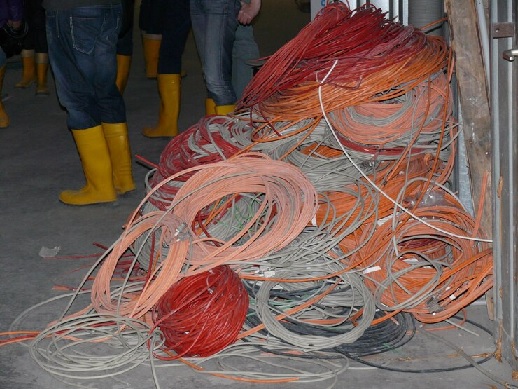Beyond Faster Phones: How 5G is Supercharging Cable Factories
When most of us think of 5G, we think of faster downloads on our smartphones. But its real transformative power might lie hidden within the walls of modern factories, including those making the very cables that form the backbone of our digital world! 5G isn’t just an upgrade; it’s a foundational technology for the next wave of industrial innovation (often called Industry 4.0), enabling smarter, faster, and more connected manufacturing processes – even for cable production.
Why is 5G a Big Deal for Factories?
Unlike previous mobile generations (or even standard Wi-Fi in some cases), 5G was designed with industrial needs in mind. It offers a unique combination of capabilities:
- Ultra-Reliable Low-Latency Communication (URLLC): This means data can be sent and received incredibly fast and reliably. Think near-instantaneous response times, crucial for controlling fast-moving machinery wirelessly.
- Enhanced Mobile Broadband (eMBB): Massive bandwidth for transferring large amounts of data quickly – perfect for high-definition video, complex sensor data streams, or Augmented Reality applications.
- Massive Machine Type Communications (mMTC): The ability to connect a huge number of devices (think thousands or even millions of sensors per square kilometer) simultaneously without overwhelming the network.
This combination unlocks possibilities that were difficult or impossible before.
5G-Powered Innovations Making Cables Smarter
So, how does this wireless tech help make wired products better?
1. Cutting the Cords (Literally!) on the Factory Floor
- Wireless Machine Control: Imagine controlling complex, moving machinery like robotic arms, AGVs, or even rotating spooling machines without physical data cables. 5G’s low latency and reliability make this feasible, allowing for more flexible factory layouts and easier reconfiguration. No more tripping hazards or expensive cable installations for every sensor!
- Untethered Sensors: Place sensors anywhere needed – on moving parts, rotating equipment, or temporary setups – without worrying about running wires. 5G (especially with mMTC) can handle the data flow from vast sensor networks.
2. Real-Time Insights on Steroids
- Massive Data Collection: Modern factories generate enormous amounts of data from sensors monitoring temperature, pressure, speed, vibration, quality, etc. 5G provides the bandwidth to collect all this data from countless sources in real-time.
- Cloud AI Analysis: This data can be instantly streamed to powerful cloud-based AI platforms for analysis. This enables sophisticated real-time quality control (spotting defects as they happen) and highly accurate predictive maintenance.
3. Supercharged Robots and AGVs
- Faster Response & Coordination: The near-instant communication enabled by 5G allows robots and Automated Guided Vehicles (AGVs) to react faster and coordinate their movements much more precisely, enabling more complex collaborative tasks safely.
4. Augmented Reality (AR) Comes Alive
- AR-Assisted Maintenance: A technician wearing AR glasses can look at a machine and see real-time data, repair instructions, or even a live video feed from a remote expert overlaid on their view. 5G’s high bandwidth and low latency make this seamless and practical, reducing repair times and errors.
- Immersive Training: Train new employees using AR guides powered by 5G, providing interactive, hands-on instructions without needing physical supervision for every step.
5. Remote Operations Become Reality
- Monitor from Anywhere: Experts can monitor production lines remotely using high-definition video streams and real-time data dashboards, all enabled by 5G connectivity.
- Remote Troubleshooting: In some cases, experts might even be able to remotely diagnose or adjust machinery settings, saving travel time and costs.
6. Linking the Supply Chain Seamlessly
- Faster, more reliable data sharing improves visibility across the supply chain. Imagine the factory’s 5G network instantly communicating production needs to quality cable suppliers in uae, ensuring materials arrive exactly when needed based on real-time factory floor data.
5G: The Glue for Smart Technologies
Think of 5G as the super-fast, super-reliable nervous system of the smart factory. It connects all the other key technologies – the Internet of Things (IoT) sensors, the AI brains analyzing data, the Cyber-Physical Systems making adjustments, and the robots doing the work – allowing them to function together seamlessly and in real-time.
What Are the Roadblocks?
Deploying 5G in factories isn’t without challenges:
- Cost: Setting up a private 5G network within a factory requires significant investment in infrastructure.
- Cybersecurity: Wireless networks introduce different security considerations than wired ones. Protecting the industrial network is critical.
- Integration: Making 5G work smoothly with existing factory systems and equipment needs careful planning.
- Spectrum: Accessing and managing the necessary radio frequencies can be complex.
The Wireless Future of Wired Production
Despite the hurdles, the potential is huge. 5G enables a level of connectivity and real-time control that paves the way for highly flexible, data-driven, and efficient manufacturing. Leading cable manufacturers in uae are exploring how 5G can provide a competitive advantage through smarter operations. As the technology matures (and we even start talking about 6G!), expect to see even more wireless innovation transforming how cables are made.
Conclusion: 5G is More Than Speed, It’s Potential
For cable manufacturing, 5G isn’t just about faster internet access within the factory. It’s a fundamental enabler for a new era of production. By providing reliable, low-latency, high-bandwidth wireless connectivity, 5G unlocks the full potential of IoT, AI, robotics, and AR on the factory floor. It’s helping to create smarter, more agile, and ultimately more efficient processes for producing the vital cables that connect our increasingly digital world.
Your 5G Factory Questions Answered (FAQs)
- Can’t factories just use Wi-Fi (like Wi-Fi 6/6E)?
While advanced Wi-Fi is capable, 5G is specifically designed for industrial environments with superior performance in key areas like ultra-low latency (critical for real-time control), reliability, and the ability to connect a massive number of devices simultaneously (mMTC), which can be challenging for Wi-Fi in dense factory settings. - What’s the single biggest advantage 5G brings to cable production?
It’s arguably the combination of ultra-reliable low-latency communication (URLLC) and massive connectivity (mMTC). This allows for reliable wireless control of machinery and the collection of data from vast numbers of sensors in real-time, enabling smarter, more adaptive processes. - Is using 5G in a factory secure?
Security is a major focus. Private 5G networks deployed within factories can be designed with robust security measures, including encryption, network slicing (isolating critical traffic), and strict access controls, potentially offering more security than traditional Wi-Fi if implemented correctly. - How does 5G specifically help with Augmented Reality (AR) maintenance?
AR applications require transmitting large amounts of data (video, 3D models, instructions) with very low delay to be useful. 5G’s high bandwidth (eMBB) and low latency (URLLC) ensure that the AR overlays are smooth, responsive, and synchronized with the real world, making them practical tools for technicians.
Are many cable factories actually using 5G right now?
Widespread adoption is still in the relatively early stages globally. Many manufacturers are currently running pilot projects or implementing 5G in specific areas. However, as the technology matures and the benefits become clearer, adoption is expected to grow significantly in the coming years.













